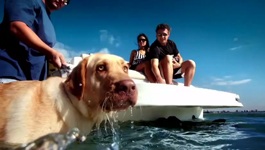Boating Lifestyle
Boating Lifestyle
There is so much to love, and learn, about boating. That's why we created this library of articles, videos and blog posts to help you throughout your adventures.
Top Tips for Green Boating

-
Clean Safely
When choosing cleaning products, look for the EcoLogoM label which is a registered mark of Environment Canada. These products have been assessed for their environmental impacts across their entire life cycle and are considered to be the "best in class". For more information about EcoLogoM visit the Environmental Choice Program. There are a wide array of products available now and you can be sure that those products that carry eco-labelling have minimal environmental impact and are safer for you and your family. Be sure when painting your boat to use legal bottom paints and biodegradable cleaning agents and ensure that no paint or cleansers enter the water.
-
Maintain Proper Equipment
Be sure that your engine reaches its designed wide-open-throttle RPM by choosing a prop with the right pitch. Adjustable-pitch propellers and modular props help to keep your boat running efficiently and ultimately reducing fuel consumption. Make sure your boat, engine and propeller blades are in good condition to avoid wasting fuel and minimizing the chances of any oil, gasoline or other hazardous materials entering the water.
Recycle Your Waste
Properly dispose of paints, batteries, antifreeze, cleaning products, oil and other hazardous wastes at a waste collection facility when you return to land. 12V batteries are among the most recycled products in the world. Some marine accessories stores even offer a credit on a new battery when you return your used one. Never discharge your sewage when you are near the shore. Check local rules and regulations for specific restrictions. Nearby pump-out stations and shore-side facilities are available for proper waste disposal.
Maintain a Clean Bilge
Consider a bioremediation product such as BIO-SOK to convert hydrocarbons into safe compounds.
Prevent Fuel Spills
Use or install a device to prevent overboard discharges from your tank vent. Such products will give you a warning and work to prevent spills when your tank is reaching its fuel capacity. Always fill your fuel tank slowly and only fill to about 90% capacity of the tank. Fuel naturally expands as the temperature rises and leaving a bit of space at the top of your fuel tank will help to prevent fuel from overflowing when its warmer outside.
Chart Your Course
Study your navigation charts and get to know the waterways so that you are familiar with the existing marine environment. You’ll be able to prevent boat propellers from potentially damaging habitats or injuring marine life, as well as consuming less fuel if you take a bit of time to plan your trip in advance and thereby avoid confusion and misdirection. Take advantage of the autopilot feature if you have it, as it can maintain a longer, continuous attention span and even steer better than some captains!
Recycle your Monofilament Fishing Line
Protect marine life by properly disposing of monofilament fishing line at nearby marine accessories stores and shore side recycling locations.
Stow Your Trash
Keep your trash onboard and never throw cigarette butts, fishing line, or any other garbage into the ocean. Take advantage of shore-side facilities to recycle plastic, glass, metal and paper. Recycle your winter storage shrink-wrap at local marinas, dealers and suppliers.


